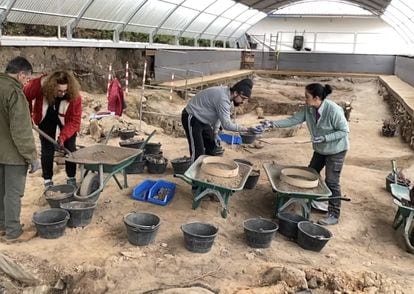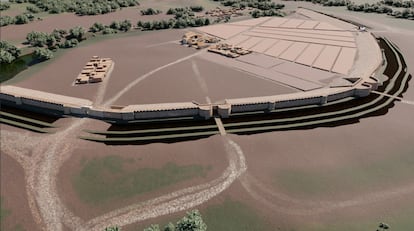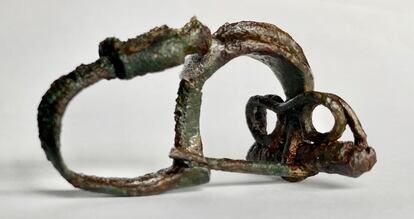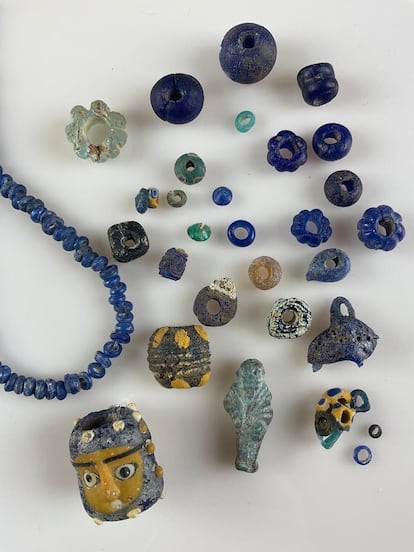Pintia (Padilla del Duero, Valladolid) is the site of the sites of the disappeared pre-Roman town of the Vacceos. But since Thursday there is less deposit. Two excavators destroyed 235 linear meters of its urban heart, destroying homes, roads, buildings and parts of its wall. In fact, remains of ceramics from 2,400 years ago, fragments of painted stucco or ashlars from its imposing constructions are more than visible on the ground opened by the steel blades of the machinery, despite the fact that a good part is already covered after the disaster. .
According to technicians, approximately 1,600 cubic meters of archaeological terrain have been completely destroyed. The Civil Guard has already opened proceedings and taken statements from those responsible. This Monday, the Minister of Culture of the Regional Government of Castilla y Léon, Gonzalo Santoja, who described the events as “inadmissible”, visited the place.
The Vacceos were a people who settled in what is now, mainly, the province of Valladolid and part of Salamanca, Ávila, Burgos or Segovia. They built various fortified cities in the Duero valley, among which Pintia stood out, a settlement that occupied about 125 hectares and that included the city itself (Las Quintas), a gigantic necropolis (Las Ruedas), where it is assumed that some 100,000 people over the centuries, and the industrial neighborhood of Carralaceña.
For 45 years, archaeologists of the Federico Wattenberg Vacceos Studies Center, from the University of Valladolid, study Pintia with the utmost care. At this time, such is the slowness of the work, they have only excavated a little more than half a hectare. The discoveries during this time are numerous. More than 30,000 objects, among which were some very delicate fibulas, horses, children's toys, weapons, jewelry, gold torcs, thousands of small clay balls whose use is unknown, decorated ceramics of the most diverse types, urns funeraries, four treasures of gold and silver… A spectacular archaeological world – the Vacceans buried themselves with beautiful grave goods, including children with their toys – that is covered by tons and tons of earth and that for decades has been plundered by the detectorists. Currently, it is protected and can be visited, so the looting has ceased or, at least, decreased.

But Pintia has a problem, it is located in the heart of the Ribera del Duero. Its clay soils are highly appreciated by farmers. As its perimeter has been declared an archaeological zone, in an attempt to make research and production activities compatible, farmers can cultivate their land, as long as they do not go deeper than 35 centimeters. For this reason, the planting of vines is prohibited, since the roots of these plants can exceed a meter in depth and destroy the spectacular Roman and Vaccean constructions that are hidden just over 50 centimeters away.

On Thursday, the two excavators, in order to introduce a water channel to irrigate the land, opened a trench 1.50 meters deep and almost a meter wide. What was the southwest neighborhood of the city, the area of origin of this settlement, was razed. In this area, precisely, a few years ago the so-called Third Treasure was found, a set of silver and gold pieces, which included earrings, coins, bracelets and torcs. So far, four with similar characteristics have been located.

The landowner flatly denies having destroyed “anything.” “That's a lie
. I have not destroyed anything and that must be proven. “If the drivers had found something, they would have stopped.” In a very elevated tone, he states: “The lands are mine. They can do it and I can't. No one has told me anything about not being able to put in a pipe, which is for producing, for eating. Let some come here and tell us what we have to do. No”.

Carlos Sanz, director of the site and professor of Prehistory at the University of Valladolid, assures, for his part, that the destroyed area “was the most densely populated in the city and was possibly its area of origin. The volume of information destroyed, up to four stratigraphic levels of 1,200 years of history, exceeds by a third the volume of excavations with archaeological methodology since we created the study center.”
Gema, a neighbor and landowner in Padilla de Duero, was also very indignant with the situation last Sunday. “We all know that we cannot go deeper than 35 centimeters into the earth. Therefore, if we want to bring water to them, we raise aerial pipes to irrigate and then dismantle them. The easy and cheap thing is to open a trench, put in pipes and carry the water to your lands. That's what they've done. It's outrageous, because Pintia is the most valuable thing we have in the municipality. It is my granddaughter's inheritance,” and she points to a girl of about 12 years old who claims that she also wants to be an archaeologist. “Of Machu Pichu,” she says while both visit an interpretation center of the site located in the municipality and which houses a selection of pieces from this culture that dominated goldsmithing, ceramics and the manufacture of weapons.
Currently, those responsible for the site are working on three projects: the exhibition Pintia. Glass jewelry for eternity, which will be inaugurated on the 24th or 25th at the Museum of the University of Valladolid (MUVa), the signage of the entire area indicating where the main roads and buildings of the Vacceo-Roman city were located, the mural reconstruction of its most notable cultural milestones, including their spectacular clothing, and the digitalization of the urban fabric. Although some could be delayed because specialists will now have to excavate the entire destroyed area to assess the damage.
All the culture that goes with you awaits you here.
Subscribe
Babelia
The literary news analyzed by the best critics in our weekly newsletter
RECEIVE IT
#excavators #destroy #linear #meters #site #Vaccea #city #Pintia #Valladolid

